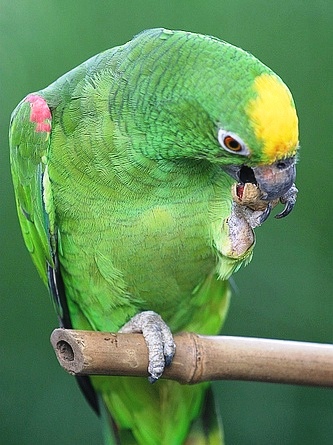
Yellow-crowned amazon, or Yellow-crowned parrot(Amazona ochrocephala)
Phylum —chordata
Class — aves
Order — psittaciformes
Family — psittacidae
Genus – amazona
Appearance
Yellow-crowned parrots have a mass of 402 to 561 g and are usually around 35 cm in length. They generally have bright green feathers edged in black with yellow markings on the head and face. Yellow-crowned parrots have yellow feathers directly above the beak. The cere and hairs around the nostrils are black. The beak is usually dark gray to black. The tail is short (about 10.16 cm) and squared-off at the base. Males and females are similar.
Habitat
This bird lives in the Amazon Basin and the Guianas, and there are further populations in Panama and the north-west of South America. It is an introduced species to Grand Cayman.
Behavior
These are sedentary social birds which only move locally in response to changes in food supply. During the night, aside from in the breeding season, these birds gather at roosts in large flocks. During the day they join smaller groups of about 10 birds when feeding. During this time, they are usually quiet. However, these birds can make a range of metallic whistles, shrieks, squawks, and repeated screeches. As with other parrots, the Yellow-crowned amazon has a flexible and complex repertoire, and can mimic human speech. Being strong fliers, they fly high on flights that cover long distances. They use shallow wing beats with no gliding, or very little. Yellow-crowned amazons are known to gather at clay-licks and associate there with other species of parrots. The territory of a Yellow-crowned amazon consists of only the area immediately surrounding its nest during the breeding season. They have a home range that is only slightly larger, dependent on the food available in the area.
Diet
The Yellow-crowned amazon is herbivore (frugivore and granivore) and eats seeds, nuts, berries, fruits, leaf buds and blossoms. They also like maize and cultivated fruits.
Reproduction
Yellow-crowned amazons are monogamous birds and pairs stay together for life. Their simple courtship display for attracting a mate includes bowing, wing-drooping and wing-flicking, foot-raising, tail-wagging, and dilation of their pupils. When roosting, pairs will remain close by each other. Up to one month prior to laying her first egg, the female prepares her nest in the hollow of a tree. The breeding period runs from December until May. 2 to 4 eggs are laid, and the mother incubates them for 24 to 27 days. The male stays close by the nest entrance and he feeds his mate. After the eggs hatch, the female will remain with the chicks for most of the time, sometimes taking a break to forage. Several days after the eggs have hatched, the male enters the nest cavity to help feed the young, though the female still carries out most of the feeding. The chicks fledge at around 56 days and are independent at about 2 months old. They reach maturity at about the age of 3 years.
In captivity
Yellow-crowned parrots, like most large parrots, have a very long lifespan. In captivity parrots can live for up to 100 years.
A roomy cage is required for the Yellow-crowned amazon. Amazon parrot cages must not be too confining, so get one that your pet will be able to feel comfortable in. It is their territory and their safe place.This parrot likes to climb and play, and enjoys expanding its wings. It is recommended that a cage be 2x3 feet wide and 2 1/2 to 5 feet high, and with a play pen top. A great thing is to have a hanging perch above that for climbing.
Yellow-crowned parrots can tolerate varying temperatures, but they need to be kept away from any drafts. They love to be out of their cage on a playpen, and will enjoy interacting with their human as well as playing with toys. A variety of perches should be used of varying size and texture. A rougher textured perch instead of the smooth, doll-rod types, makes it easier for them to perch and is better for their feet and legs. A concrete perch can be placed as the highest perch in the cage and next to a toy. At times during the day they will perch there and it will save them (and you) from the ordeal of having their nails filed.
Learn to have fun during bath time. Whether you spritz your amazon with water or an aloe spritz, or just put him in the kitchen sink, make it fun. Your amazon will teach you how he likes to be bathed.
A pet bird will enjoy a varied diet, including a quality seed mix or a pelleted diet, and many fresh fruits and vegetables. Pellets will work if started at an early age. Plenty of human food that is nutritious can be offered, and they like chicken. They like to eat at the table and enjoy eating with their family. Avocado and chocolate are toxic to any parrot. They will let you know when it's dinner time.
 Russian
Russian
 English
English























